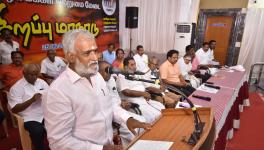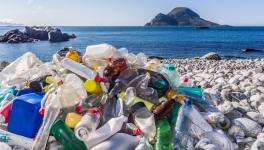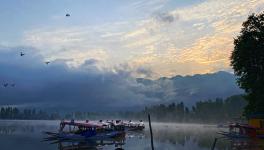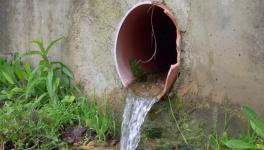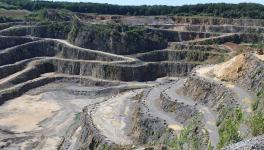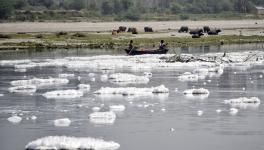Shrimp Farms Cause Water, Soil Pollution on Rameswaram Island
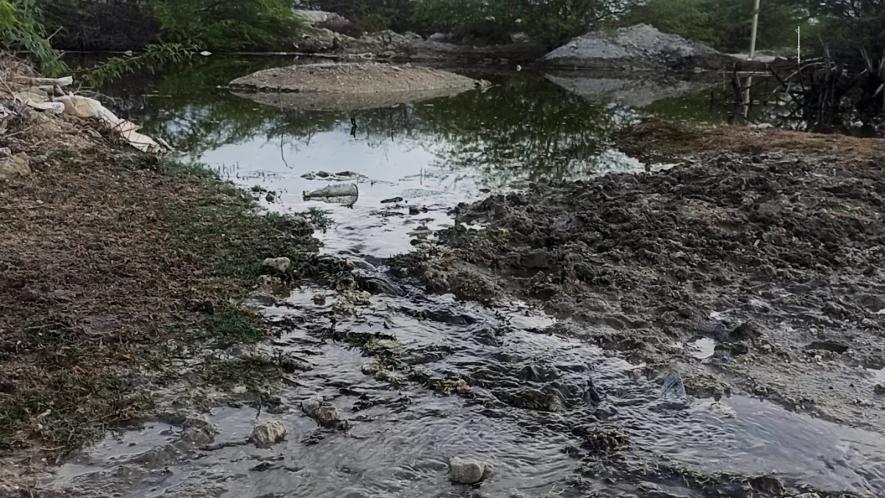
Water discharge from shrimp farms has become the primary source of pollution in villages around Rameswaram.
Shrimp farming has become the bane of the villages of Rameswaram island in Tamil Nadu. Shrimp farms cause soil and water pollution, affecting the groundwater table and farming in the villages. Despite the increasing environmental concerns and ecological issues, protests by the villagers against civic bodies and the district administration have fallen on deaf ears.
Shrimp farming was introduced in the state in the 1990s by the fisheries department to improve employment prospects and meet food security and nutritional requirements. Shrimp exports contribute significantly to sustaining the industry.
As per the department of fisheries and fishermen welfare website of the government of Tamil Nadu, the state has a brackish water area of 56,000 hectares (ha) of which 14,880 ha is readily available for aquaculture-related activities.
Ramanathapuram is one among the 12 maritime districts where shrimp aquaculture is being developed. With 900 ha of brackish water area and 1,385 ha of potential area readily available, plus the island’s geographical location, the district is more suitable for shrimp farming. Tiger shrimp and white shrimp are cultured in the shrimp ponds in the state.
In the process, the fertile land and rich groundwater table of the island have been severely affected. The discharge of polluted water from the shrimp farms into the farmlands and water bodies is a regular affair in the villages around Rameswaram.
“The 46-acre pond in Mangadu village is a water source to around 13 villages and the theerthams (holy ponds/wells) inside the temple. A farm on the other side of the pond discharges polluted water into it,” M Karunamurthy, working president, Tamil Nadu Fisheries and Fish Workers Federation, told Newsclick.
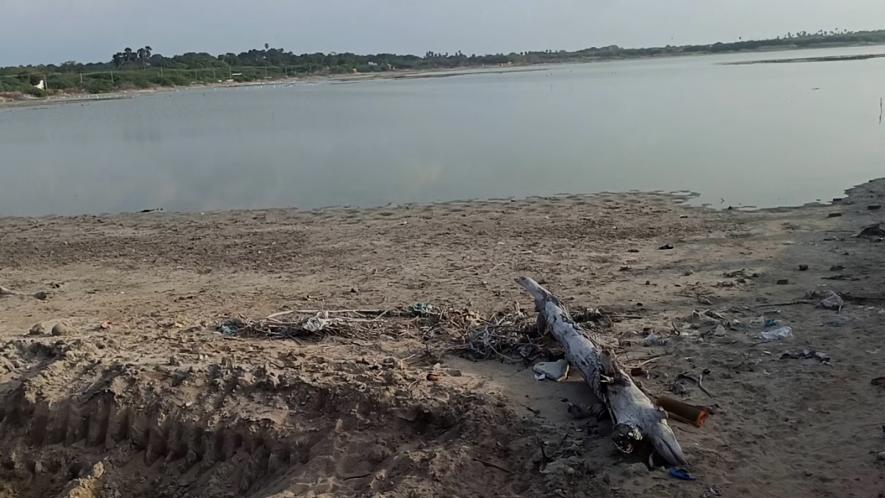
Wastewater discharge from shrimp farms and encroachments have polluted the pond in Mangadu village.
Panjamma, a resident of Mangadu village, recalled the years when drinking water was available in plenty in wells 25-30-feet deep. “Now, we pay Rs 5 per pot of water. Things changed when the farms started to encroach on our villages,” she told Newsclick.
The residents alleged that shrimp growing ponds are being constructed in violation of laws. “The ground and walls of the pits must be covered by plastic sheets to prevent water absorption. But the farm owners constructed only one pit to convince the inspecting officials, who refuse to take action despite knowing the reality,” Karunamurthy said.
(Left) A model pond was constructed by shrimp farm owners to show that rules are being followed. (Right) The ponds without plastic sheets, which cause pollution.
The residents accuse the farm owners of having constructed the ponds without government approval. According to the fisheries department website, out of the 2,086 shrimp farms in the 12 coastal districts, only 852 have been approved.
The groundwater level has also reduced and the water has become highly polluted. “The farms require both hard and pure water for the shrimps to hatch. Instead of taking water from the sea, the farm owners dig a borewell for about 300 feet to get hard water. Some borewells are also used to get pure water. The discharge of water from the farms has become a long-term problem for the residents,” said Muniyandi, the village head of Mangadu.
The temple and municipal administration have also been accused of violating laws. A road across the pond that leads to the parking area of the temple is under construction.
Karunamurthy accused the Hindu Religious & Charitable Endowments department and the municipal administration of violating rules. “The municipality is dumping waste on one side of the pond. They have constructed a parking area on the far end and a road. A road that will pass through the middle of the pond and lead to the parking area is being constructed. This is a violation of the highest order. We suspect bureaucratic and political collusion in such crucial issues,” he said.
(Left) The road being built across Mangadu pond leads to the parking area of the temple (right).
“We have held several protests against the violation by the farm owners and the administration to save ourselves and the environment. But the authorities have not taken action,” said Kowsalya, a resident of Mangadu.
The 13 villages surrounding the Rameswaram temple were once known for cultivating rainfed crops and cereals. Paulraj, from Ariyankundu village, told Newsclick that he used to cultivate bajra and ragi a couple of decades ago. “The water discharge from the farms has affected the fertility of the soil and farming is not possible now.”
Water discharge from shrimp farms has become the primary source of pollution in villages around Rameswaram.
The area under farming reduced after the devastating Rameswaram cyclone in 1964, but farmers continued cultivating crops until the shrimp farming boom.
The shrimp farms close to the shores of the island are affecting the marine ecosystem as well. “The water from the farms, which contains several chemicals, is discharged back to the sea. The farm owners use several chemical fertilisers to boost the growth of shrimps,” said Arulrai, a member of the fishing community.
(Left) Seawater is being pumped to shrimp farms. (Right) Processed water from the farms is being discharged to the sea.
“We have seen a lot of resources, including lime blocks, which were once used for whitewashing houses, disappear. Several people were dependent on collecting seashells and pine corns for their livelihood. But all such things have disappeared due to the pollution,” Arulrai added.
“If the pollution continues for a few more years, Rameswaram island will become uninhabitable,” Karunamurthy said.
Shrimp farming has become the bane of the villages of Rameswaram island in Tamil Nadu. Shrimp farms cause soil and water pollution, affecting the groundwater table and farming in the villages. Despite the increasing environmental concerns and ecological issues, protests by the villagers against civic bodies and the district administration have fallen on deaf ears.
Shrimp farming was introduced in the state in the 1990s by the fisheries department to improve employment prospects and meet food security and nutritional requirements. Shrimp exports contribute significantly to sustaining the industry.
As per the department of fisheries and fishermen welfare website of the government of Tamil Nadu, the state has a brackish water area of 56,000 hectares (ha) of which 14,880 ha is readily available for aquaculture-related activities.
Ramanathapuram is one among the 12 maritime districts where shrimp aquaculture is being developed. With 900 ha of brackish water area and 1,385 ha of potential area readily available, plus the island’s geographical location, the district is more suitable for shrimp farming. Tiger shrimp and white shrimp are cultured in the shrimp ponds in the state.
In the process, the fertile land and rich groundwater table of the island have been severely affected. The discharge of polluted water from the shrimp farms into the farmlands and water bodies is a regular affair in the villages around Rameswaram.
“The 46-acre pond in Mangadu village is a water source to around 13 villages and the theerthams (holy ponds/wells) inside the temple. A farm on the other side of the pond discharges polluted water into it,” M Karunamurthy, working president, Tamil Nadu Fisheries and Fish Workers Federation, told Newsclick.
Image: Wastewater discharge from shrimp farms and encroachments have polluted the pond in Mangadu village.
Panjamma, a resident of Mangadu village, recalled the years when drinking water was available in plenty in wells 25-30-feet deep. “Now, we pay Rs 5 per pot of water. Things changed when the farms started to encroach on our villages,” she told Newsclick.
The residents alleged that shrimp growing ponds are being constructed in violation of laws. “The ground and walls of the pits must be covered by plastic sheets to prevent water absorption. But the farm owners constructed only one pit to convince the inspecting officials, who refuse to take action despite knowing the reality,” Karunamurthy said.
(Left) A model pond was constructed by shrimp farm owners to show that rules are being followed. (Right) The ponds without plastic sheets, which cause pollution.
The residents accuse the farm owners of having constructed the ponds without government approval. According to the fisheries department website, out of the 2,086 shrimp farms in the 12 coastal districts, only 852 have been approved.
The groundwater level has also reduced and the water has become highly polluted. “The farms require both hard and pure water for the shrimps to hatch. Instead of taking water from the sea, the farm owners dig a borewell for about 300 feet to get hard water. Some borewells are also used to get pure water. The discharge of water from the farms has become a long-term problem for the residents,” said Muniyandi, the village head of Mangadu.
The temple and municipal administration have also been accused of violating laws. A road across the pond that leads to the parking area of the temple is under construction.
Karunamurthy accused the Hindu Religious & Charitable Endowments department and the municipal administration of violating rules. “The municipality is dumping waste on one side of the pond. They have constructed a parking area on the far end and a road. A road that will pass through the middle of the pond and lead to the parking area is being constructed. This is a violation of the highest order. We suspect bureaucratic and political collusion in such crucial issues,” he said.
(Left) The road being built across Mangadu pond leads to the parking area of the temple (right).
“We have held several protests against the violation by the farm owners and the administration to save ourselves and the environment. But the authorities have not taken action,” said Kowsalya, a resident of Mangadu.
The 13 villages surrounding the Rameswaram temple were once known for cultivating rainfed crops and cereals. Paulraj, from Ariyankundu village, told Newsclick that he used to cultivate bajra and ragi a couple of decades ago. “The water discharge from the farms has affected the fertility of the soil and farming is not possible now.”
Water discharge from shrimp farms has become the primary source of pollution in villages around Rameswaram.
The area under farming reduced after the devastating Rameswaram cyclone in 1964, but farmers continued cultivating crops until the shrimp farming boom.
The shrimp farms close to the shores of the island are affecting the marine ecosystem as well. “The water from the farms, which contains several chemicals, is discharged back to the sea. The farm owners use several chemical fertilisers to boost the growth of shrimps,” said Arulrai, a member of the fishing community.
(Left) Seawater is being pumped to shrimp farms. (Right) Processed water from the farms is being discharged to the sea.
“We have seen a lot of resources, including lime blocks, which were once used for whitewashing houses, disappear. Several people were dependent on collecting seashells and pine corns for their livelihood. But all such things have disappeared due to the pollution,” Arulrai added.
“If the pollution continues for a few more years, Rameswaram island will become uninhabitable,” Karunamurthy said.
Get the latest reports & analysis with people's perspective on Protests, movements & deep analytical videos, discussions of the current affairs in your Telegram app. Subscribe to NewsClick's Telegram channel & get Real-Time updates on stories, as they get published on our website.











